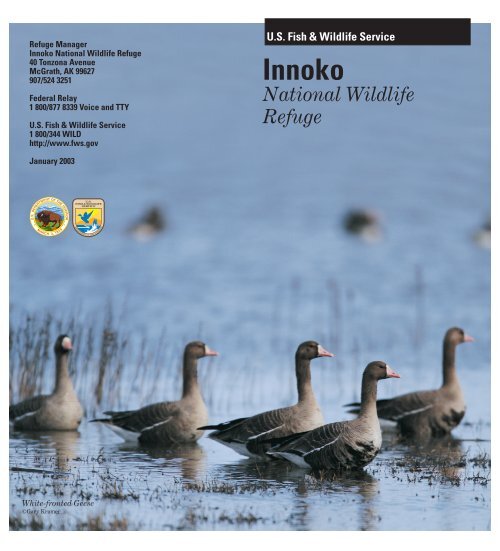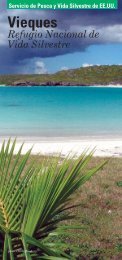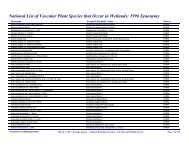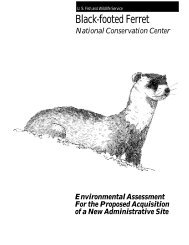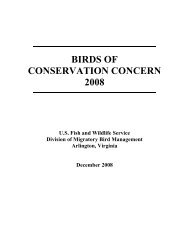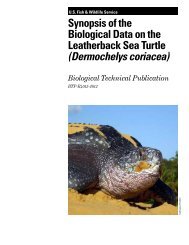Innoko - Conservation Library - U.S. Fish and Wildlife Service
Innoko - Conservation Library - U.S. Fish and Wildlife Service
Innoko - Conservation Library - U.S. Fish and Wildlife Service
Create successful ePaper yourself
Turn your PDF publications into a flip-book with our unique Google optimized e-Paper software.
Refuge Manager<br />
<strong>Innoko</strong> National <strong>Wildlife</strong> Refuge<br />
40 Tonzona Avenue<br />
McGrath, AK 99627<br />
907/524 3251<br />
Federal Relay<br />
1 800/877 8339 Voice <strong>and</strong> TTY<br />
U.S. <strong>Fish</strong> & <strong>Wildlife</strong> <strong>Service</strong><br />
1 800/344 WILD<br />
http://www.fws.gov<br />
January 2003<br />
White-fronted Geese<br />
©Gary Kramer<br />
U.S. <strong>Fish</strong> & <strong>Wildlife</strong> <strong>Service</strong><br />
<strong>Innoko</strong><br />
National <strong>Wildlife</strong><br />
Refuge
<strong>Innoko</strong> River<br />
Henry Minardi/USFWS<br />
“The <strong>Innoko</strong> <strong>and</strong><br />
Iditarod rivers flow<br />
through the unit<br />
which has excellent<br />
habitat for waterfowl,<br />
moose, black bears<br />
<strong>and</strong> furbearers.”<br />
Senate Report associated with the Alaska National<br />
Interest L<strong>and</strong>s Claim Act, 1980.
This flying<br />
“Blue Goose”<br />
(a stylized<br />
Canada goose)<br />
was designed<br />
by renowned<br />
cartoonist <strong>and</strong><br />
conservationist<br />
J.N. “Ding”<br />
Darling in 1935.<br />
It has becomethe<br />
symbol of the<br />
National <strong>Wildlife</strong><br />
Refuge System.<br />
Managed by<br />
Forces of Nature<br />
The mission of the National <strong>Wildlife</strong><br />
Refuge System is to administer a<br />
national network of l<strong>and</strong>s <strong>and</strong> waters<br />
for the conservation, management,<br />
<strong>and</strong> where appropriate, restoration of<br />
the fish, wildlife <strong>and</strong> plant resources<br />
<strong>and</strong> their habitats within the United<br />
States for the benefit of present <strong>and</strong><br />
future generations of Americans.<br />
The <strong>Innoko</strong> National <strong>Wildlife</strong> Refuge<br />
in Interior Alaska<br />
Remote <strong>and</strong> isolated even by Alaska<br />
st<strong>and</strong>ards, the 3.85 million acre<br />
<strong>Innoko</strong> National <strong>Wildlife</strong> Refuge is<br />
one of the most important waterfowl<br />
areas in Interior Alaska. The refuge<br />
provides nesting <strong>and</strong> molting habitat<br />
for hundreds of thous<strong>and</strong>s of geese,<br />
ducks, loons <strong>and</strong> swans. It also<br />
provides excellent habitat for moose<br />
<strong>and</strong> a large variety of raptors. Rich in<br />
history <strong>and</strong> natural resources, the<br />
refuge offers people a unique<br />
opportunity to observe fish <strong>and</strong><br />
wildlife in a natural <strong>and</strong> relatively<br />
undisturbed habitat.<br />
Much of the refuge is relatively flat<br />
lowl<strong>and</strong>. Due to frequent natural<br />
flooding, slow moving river systems<br />
support rich wetl<strong>and</strong> communities .<br />
Natural wildfires may burn around<br />
200,000 acres of habitat each year.<br />
These forces of nature create a<br />
healthy mosaic of plants in different<br />
stages of succession, providing habitat<br />
for waterfowl, moose, bears, wolves<br />
<strong>and</strong> other wildlife, as well as resident<br />
<strong>and</strong> neotropical birds.<br />
Natural<br />
Boundaries<br />
Wildfire in Spruce<br />
Without fences or signs to define its<br />
boundaries, the refuge relies on<br />
natural features instead. The refuge is<br />
bordered on the north by the Khotol<br />
Hills, on the east <strong>and</strong> south by the<br />
Kuskokwim Mountains, <strong>and</strong> on the<br />
west by the mighty Yukon River. The<br />
<strong>Innoko</strong> River flows through its center,<br />
dividing the northern portion of the<br />
refuge from the southern <strong>Innoko</strong><br />
Wilderness Area.<br />
Bob Skinner/USFWS
Moose<br />
Sally Collins/USFWS<br />
Ducklings<br />
USFWS<br />
Established to Maintain<br />
Natural Diversity<br />
The <strong>Innoko</strong> National <strong>Wildlife</strong><br />
Refuge was established in 1980 by<br />
the Alaska National Interest L<strong>and</strong>s<br />
<strong>Conservation</strong> Act (ANILCA). A<br />
main purpose of the refuge is the<br />
conservation of fish <strong>and</strong> wildlife<br />
populations <strong>and</strong> habitats in their<br />
natural diversity. Management<br />
efforts focus on protecting these<br />
natural resources <strong>and</strong> providing for<br />
public use. The Northern Unit of the<br />
refuge, also called Kaiyah Flats, is<br />
administered by the Koyukuk/<br />
Nowitna National <strong>Wildlife</strong> Refuge<br />
Complex in Galena. The Southern<br />
Unit is administered by the <strong>Innoko</strong><br />
National <strong>Wildlife</strong> Refuge<br />
Headquarters in McGrath.<br />
Part of a Nationwide<br />
System of Refuges<br />
The <strong>Innoko</strong> National <strong>Wildlife</strong><br />
Refuge is one of more than 540<br />
refuges in the National <strong>Wildlife</strong><br />
Refuge System. Administered by<br />
the U.S. <strong>Fish</strong> <strong>and</strong> <strong>Wildlife</strong> <strong>Service</strong>,<br />
these refuges stretch across the<br />
United States from above the Arctic<br />
Circle in Alaska to the subtropical<br />
waters of the Caribbean <strong>and</strong> South<br />
Pacific. The mission of the U.S. <strong>Fish</strong><br />
<strong>and</strong> <strong>Wildlife</strong> <strong>Service</strong> is working with<br />
others to conserve, protect <strong>and</strong><br />
enhance fish, wildlife, plants <strong>and</strong><br />
their habitats for the continuing<br />
benefit of the American people.<br />
A L<strong>and</strong> Rich in Resources<br />
The Athabaskan people lived along<br />
the <strong>Innoko</strong> <strong>and</strong> Iditarod rivers for<br />
centuries, in villages called Dishkaket,<br />
Dementi, Holikachuk <strong>and</strong> Old<br />
Shageluk. They also used a variety of<br />
seasonal campsites, depending on the<br />
resources being harvested. As<br />
hunters <strong>and</strong> gatherers, their very<br />
survival depended on the harvest of<br />
plants, animals <strong>and</strong> fish. These rich,<br />
renewable resources provided food,<br />
Lina Demoski<br />
weaves a basket<br />
at the <strong>Innoko</strong><br />
Environmental<br />
Science Camp.<br />
©Kathy Bushue<br />
Subsistence <strong>and</strong><br />
Preserving<br />
a Way of Life<br />
Subsistence Use by Local Residents<br />
shelter, fuel, clothing, tools, <strong>and</strong><br />
barter for other needed supplies.<br />
The Athabaskan people set up spring<br />
camps to harvest furbearers <strong>and</strong><br />
waterfowl, <strong>and</strong> summer camps for<br />
fishing <strong>and</strong> picking berries. The<br />
summer camps, also called “canoe<br />
camps,” were often located near the<br />
forks of rivers or along the Yukon<br />
River, where salmon <strong>and</strong> whitefish<br />
runs were abundant. Hunters roamed<br />
the l<strong>and</strong> year-round in search of<br />
caribou, waterfowl <strong>and</strong> other wild<br />
game. Since the expansion of moose<br />
into the <strong>Innoko</strong> area in the early<br />
1900s, this large mammal has been<br />
eagerly sought as a major food source<br />
in the local diet.<br />
Although there are no communities<br />
within the refuge boundaries today,<br />
residents of adjacent villages on the<br />
lower <strong>Innoko</strong> <strong>and</strong> Yukon rivers<br />
continue to harvest the l<strong>and</strong>’s<br />
resources to feed their families <strong>and</strong><br />
to preserve local cultural practices.<br />
ANILCA recognized this historic,<br />
cultural lifestyle <strong>and</strong> provides rural<br />
residents with continued<br />
opportunities for subsistence use.<br />
USFWS
Wolf Pup on River Bank<br />
Gold <strong>and</strong> the<br />
Iditarod Trail<br />
Gold rush fever struck Interior<br />
Alaska in the early 1900s. After gold<br />
was discovered on tributaries of the<br />
<strong>Innoko</strong> <strong>and</strong> Iditarod rivers, supply<br />
towns sprang up on what is now the<br />
refuge. Between 1908 <strong>and</strong> 1911,<br />
when the Alaska Road Commission<br />
was building a winter overl<strong>and</strong> trail<br />
between Seward <strong>and</strong> Nome for the<br />
delivery of mail, it became clear that<br />
a branch trail to the growing<br />
support town of Iditarod <strong>and</strong> other<br />
supply towns was needed. This trail<br />
system became known as the<br />
Iditarod Trail, now a designated<br />
National Historical Trail. The gold<br />
boom was short lived. Supply towns<br />
<strong>and</strong> roadhouses were ab<strong>and</strong>oned<br />
<strong>and</strong> now add to the historical <strong>and</strong><br />
cultural appeal of the refuge. The<br />
trail used by today’s Iditarod Sled<br />
Dog Race is just outside the<br />
refuge’s southern boundary in odd<br />
years <strong>and</strong> northern boundary in<br />
even years.<br />
USFWS<br />
Sundew<br />
Franzi Abplanalp/USFWS<br />
Bogs<br />
Wet Meadows<br />
Bog<br />
Natural Ecosystems<br />
Largely undisturbed by humans,<br />
the refuge vegetation reflects a<br />
transition zone between the<br />
spruce, birch <strong>and</strong> aspen boreal<br />
forest of Interior Alaska <strong>and</strong> the<br />
tundra regions common in<br />
western <strong>and</strong> northern Alaska.<br />
These natural ecosystems<br />
provide the food, shelter <strong>and</strong><br />
water wildlife need to survive.<br />
Raised isl<strong>and</strong>s of black spruce <strong>and</strong><br />
tamarack are scattered throughout<br />
the bogs in the refuge lowl<strong>and</strong>s. With<br />
their thick, floating mats of sphagnum<br />
moss, the bogs are home to unique<br />
plants such as sundews, Andromeda<br />
<strong>and</strong> bog cranberry. As the underlying<br />
permafrost melts <strong>and</strong> refreezes, bogs<br />
go through constant, although<br />
gradual, changes. Red-backed voles<br />
<strong>and</strong> many species of birds are<br />
abundant on the bog isl<strong>and</strong>s. S<strong>and</strong>hill<br />
cranes <strong>and</strong> shorebirds such as the<br />
Hudsonian godwit use the open areas<br />
as nesting sites.<br />
Wet meadows of tussock grasses<br />
<strong>and</strong> sedges are common along the<br />
river floodplains. Maintained by<br />
seasonal flood cycles, these natural<br />
marshes are extremely important<br />
for waterfowl <strong>and</strong> other birds.<br />
They also provide needed habitat<br />
for Interior Alaska’s only known<br />
amphibian – the wood frog.<br />
Bob Skinner/USFWS
Spruce Forests<br />
<strong>and</strong> Willow<br />
S<strong>and</strong>bars<br />
Birch <strong>and</strong> Spruce<br />
C<strong>and</strong>ace Stoughton/<br />
USFWS<br />
<strong>Innoko</strong><br />
Wilderness Area<br />
Low hills of spruce <strong>and</strong> birch cover<br />
nearly half of the refuge. Forests of<br />
stunted black spruce with an<br />
understory of lichens <strong>and</strong> mosses<br />
blanket the cold permafrost sites.<br />
Large st<strong>and</strong>s of white spruce<br />
dominate the well-drained hillsides<br />
facing south, as well as riverside<br />
terrain where flooding thaws the<br />
permafrost <strong>and</strong> supports their<br />
growth. These old growth forests<br />
provide winter cover for moose <strong>and</strong><br />
year-round habitat for red squirrels<br />
<strong>and</strong> black <strong>and</strong> grizzly bears. Along the<br />
rivers <strong>and</strong> sloughs, dense willow<br />
st<strong>and</strong>s interspersed with spruce<br />
woods provide winter food <strong>and</strong> cover<br />
for moose, beaver, snowshoe hare <strong>and</strong><br />
other wildlife. Historically, fires<br />
sparked by lightning returned vast<br />
areas to early successional stages of<br />
aspen, birch, willow <strong>and</strong> alder. Even<br />
today fire continues to play an<br />
important part in shaping the habitats<br />
of the refuge.<br />
One third of the 3.85 million acre<br />
refuge is designated the <strong>Innoko</strong><br />
Wilderness Area. Motorized<br />
equipment is prohibited on wilderness<br />
l<strong>and</strong>s, but ANILCA makes exceptions<br />
for snow machines, motorboats <strong>and</strong><br />
airplanes for traditional use <strong>and</strong><br />
access. Chainsaws may be used only<br />
for qualified subsistence purposes in<br />
Wilderness Areas.<br />
A vast acreage of lakes <strong>and</strong> bogs form the <strong>Innoko</strong> NWR<br />
Robert Fernau/USFWS<br />
Redpoll<br />
Birds of<br />
the North<br />
Spruce Grouse<br />
USFWS<br />
A Home For <strong>Wildlife</strong><br />
The refuge is home to a diversity of<br />
wildlife well adapted to the extreme<br />
weather conditions of Interior Alaska.<br />
Each season yields new opportunities<br />
for wildlife observation. Whether you<br />
are following wolf tracks in the snow<br />
in the winter, or spotting a moose cow<br />
with her calves along the <strong>Innoko</strong><br />
River in summer, a visit to the refuge<br />
can be a truly rewarding experience.<br />
Approximately 20 species of birds,<br />
including owls, woodpeckers, grouse,<br />
chickadees, gray jays, juncos, redpolls<br />
<strong>and</strong> ravens, are year-round residents<br />
of the refuge. More than 100 different<br />
species of birds nest here, including<br />
waterfowl <strong>and</strong> an abundance of<br />
neotropical migrants who fly<br />
thous<strong>and</strong>s of miles each spring to<br />
return to the pristine upl<strong>and</strong> forests,<br />
river corridors <strong>and</strong> vast wetl<strong>and</strong>s of<br />
the refuge. The long-distance record<br />
for migration belongs to the arctic<br />
tern. Each year it travels from its<br />
wintering grounds in the Antarctic to<br />
the <strong>Innoko</strong> Refuge – approximately<br />
20,000 miles round trip!<br />
USFWS
Songs of<br />
New Life<br />
Trumpeter Swan<br />
USFWS<br />
Lesser Yellowlegs<br />
USFWS<br />
Canvasbacks<br />
In the spring – sometimes even<br />
before the ice melts – trumpeter<br />
swans, greater white-fronted <strong>and</strong><br />
Canada geese, wigeons, pintails,<br />
common <strong>and</strong> Barrows goldeneyes,<br />
green-winged teals, shovelers <strong>and</strong><br />
several species of loons arrive on the<br />
refuge. Their nesting <strong>and</strong> molting<br />
areas are scattered throughout the<br />
wetl<strong>and</strong>s. In June, at the height of<br />
the breeding season, the refuge is<br />
alive with the songs of flycatchers,<br />
thrushes, sparrows <strong>and</strong> warblers.<br />
Shorebirds, such as greater <strong>and</strong><br />
lesser yellowlegs, spotted<br />
s<strong>and</strong>pipers, snipe <strong>and</strong> Hudsonian<br />
godwits, can be seen <strong>and</strong> heard<br />
along the river corridors <strong>and</strong> on the<br />
vast expanse of marshes <strong>and</strong> bogs.<br />
Raptors, including peregrine falcons,<br />
ospreys, bald eagles <strong>and</strong> red-tailed<br />
hawks, soar above the treetops.<br />
Breeding season is short in Interior<br />
Alaska. Migratory birds begin their<br />
journey south or to the coast of<br />
Alaska in August, <strong>and</strong> are<br />
completely gone by the end of<br />
September when the rivers <strong>and</strong><br />
lakes change to ice.<br />
USFWS<br />
Grizzly Bear<br />
L<strong>and</strong> Mammals<br />
<strong>Fish</strong> Resources<br />
A variety of mammals, including black<br />
<strong>and</strong> grizzly bears, lynx, wolverines,<br />
river otters, beavers <strong>and</strong> porcupines,<br />
live on the refuge. The river corridors<br />
provide excellent habitat for some<br />
of Alaska’s largest moose. Wolves<br />
are seen <strong>and</strong> heard on the refuge<br />
throughout the year. A small herd<br />
of caribou travels year-round<br />
between refuge l<strong>and</strong>s <strong>and</strong> the Beaver<br />
Mountains (just east of the refuge<br />
boundary). Smaller mammals on the<br />
refuge include snowshoe hare, red fox,<br />
red squirrel, marten, muskrat, weasel,<br />
mink, vole, jumping mice, <strong>and</strong> several<br />
species of shrew.<br />
The <strong>Innoko</strong> River <strong>and</strong> its tributaries<br />
provide important spawning <strong>and</strong><br />
rearing habitat for many species of<br />
fish. The refuge’s <strong>Innoko</strong> River<br />
chinook “king” salmon are part of the<br />
Yukon River run – one of the largest<br />
natural salmon runs of any river<br />
system in the world. Other fish<br />
species in refuge rivers <strong>and</strong> lakes<br />
include coho <strong>and</strong> chum salmon, Dolly<br />
Varden, grayling, burbot, northern<br />
pike, <strong>and</strong> several species of whitefish<br />
including sheefish.<br />
USFWS
<strong>Fish</strong>ing for<br />
Northern Pike<br />
USFWS<br />
Moose Hunters<br />
Explore the Wilderness<br />
You are welcome to explore the<br />
refuge. Due to its isolation, it does not<br />
receive many visitors except for local<br />
residents. Pike <strong>and</strong> salmon fishermen<br />
visit during the summer months,<br />
while moose hunters gather in<br />
September. Fur trappers from<br />
adjacent Yukon River villages run<br />
trap lines here in winter, <strong>and</strong><br />
subsistence waterfowl hunters visit in<br />
the spring <strong>and</strong> fall. Because there are<br />
no facilities or trails, camping <strong>and</strong><br />
backpacking are primitive activities.<br />
In the summer, a boat or float plane<br />
will take you onto the refuge. Winter<br />
access is limited to snow machine, dog<br />
sled or ski-equipped airplane.<br />
Private l<strong>and</strong> inholdings, native<br />
corporation l<strong>and</strong>s, native allotments<br />
<strong>and</strong> privately-owned cabins are<br />
located throughout refuge. If you are<br />
uncertain about l<strong>and</strong> status, contact<br />
the refuge office.<br />
Refuge Visitation Basics<br />
The refuge office is located in<br />
McGrath. Refuge staff are available to<br />
provide information <strong>and</strong> help make<br />
your trip enjoyable. Commercial<br />
guides <strong>and</strong> air transportation<br />
operators on refuge l<strong>and</strong>s are<br />
required to obtain a refuge permit.<br />
USFWS<br />
Mosquitos provide food for waterfowl <strong>and</strong> other birds.<br />
Environmental<br />
Concerns<br />
n Be prepared for changing weather.<br />
Anticipate rain at any time during<br />
spring, summer or fall. Carry rain<br />
gear <strong>and</strong> spare warm clothes. Hip<br />
or knee boots are recommended,<br />
since much of the refuge is<br />
low-lying marsh <strong>and</strong> bog. Bring a<br />
mosquito-proof tent <strong>and</strong> a warm<br />
sleeping bag. Carry a good first aid<br />
kit <strong>and</strong> plenty of insect repellent.<br />
n High temperatures may exceed<br />
80˚ F in the summer months,<br />
although 50˚ F to 70˚ F<br />
temperatures are more common.<br />
An unexpected freeze can happen<br />
even in the summer. Expect cold,<br />
wet weather during the September<br />
moose season. Winters are very<br />
cold – temperatures may drop to<br />
below -60˚ F for long stretches<br />
of time.<br />
n Many areas of the refuge accessible<br />
by aircraft or boat are located along<br />
river corridors. A rapid rise in water<br />
can occur quickly, especially after it<br />
rains, so choose your campsite<br />
with caution.<br />
USFWS
Sunset at <strong>Innoko</strong> NWR<br />
<strong>Wildlife</strong><br />
Concerns<br />
Preserving the<br />
L<strong>and</strong> for Future<br />
Generations<br />
n Giardia lamblia, which causes<br />
“beaver fever,” may be present<br />
in any refuge water. Boil all<br />
drinking water or use an<br />
alternate water purifying system.<br />
n This is bear country. In most cases<br />
bears are not a threat, but they do<br />
deserve your respect <strong>and</strong><br />
attention. If a bear is shot in<br />
self-defense, you must follow<br />
State of Alaska salvage rules. For<br />
additional information about<br />
traveling in bear country, please<br />
refer to the publication “Bear<br />
Facts - The Essentials for<br />
Traveling in Bear Country,”<br />
available from the refuge office.<br />
n You may use any dead or down<br />
trees for firewood.<br />
n Disturbing <strong>and</strong>/or the collection of<br />
artifacts <strong>and</strong> paleontological<br />
remains is against the law!<br />
n Adopt the “leave no trace” ethic,<br />
including packing out all garbage.<br />
USFWS<br />
“Af ter spring cleanup…,<br />
Blanche <strong>and</strong> I loaded our<br />
canoe <strong>and</strong> started for<br />
Iditarod…. On reaching the<br />
mouth of the Tolstoi we were<br />
invited to go down to the<br />
mouth of the Iditarod on the<br />
steamer Pup…. We could sit<br />
out on deck <strong>and</strong> see moose<br />
feeding in grass shoulderhigh.<br />
We took to our canoe at<br />
Dementi’s…. The valley is at<br />
this place about fifty miles<br />
wide <strong>and</strong> was almost<br />
entirely covered with water<br />
…. [W]e encountered head<br />
winds <strong>and</strong> l<strong>and</strong>ed on a<br />
small isl<strong>and</strong>. There were<br />
about a million little<br />
songbirds here, waiting for<br />
the water to go down.”<br />
James S. Pitcher, Sourdough Jim Pitcher – The<br />
Autobiography of a Pioneer Alaskan, 1985.<br />
<strong>Innoko</strong> River<br />
Henry Minardi/USFWS


